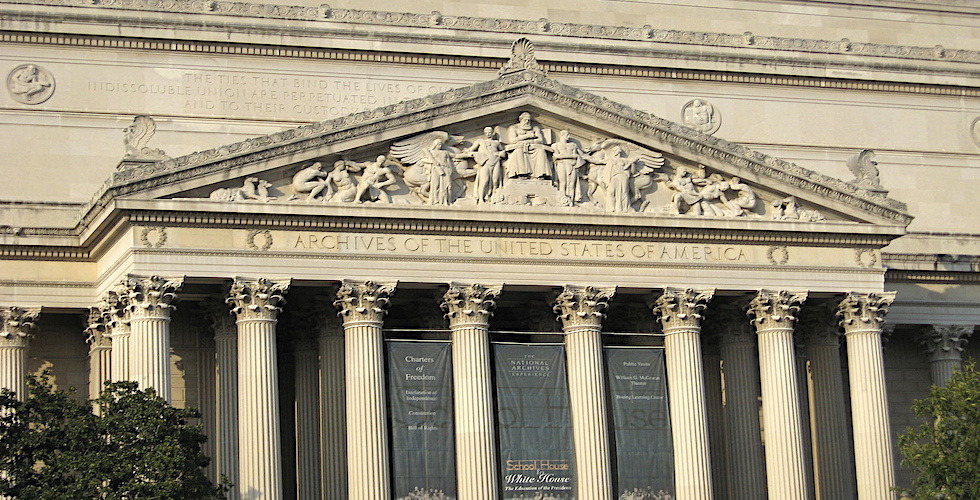The national archives is the warehouse for the official, historic, and important public records of the United States. Besides the U.S. Declaration of Independence and Constitution, it holds more than 10 billion pages of documents; 12 million maps, charts, and architectural drawings; 25 million photos; and 700,000 sound and video recordings. The archives also hold millions of records on U.S. military service and family genealogy.
The presentations are spread over two floors: the ground level contains an orientation area, the Record of Rights exhibition, and the archives’ store. The upper level contains the Charters of Freedom Rotunda, holding the Declaration of Independence and the Constitution, plus other exhibits pulled from the archives collection and shown on the same floor. There’s also a lower level basement for the archives’ small café.
GROUND LEVEL
The Record of Rights, in the David M. Rubenstein gallery, is a permanent exhibit on the evolution of U.S. citizens’ rights over time. It begins with a look at the English Magna Carta from 1297. The Magna Carta was originally written in 1215 by rebellious wealthy English landowners fed up with King John’s often capricious treatment and above-the-law behavior. The original document was essentially a peace treaty between the two sides, spelling out a specific list of rights and responsibilities each side would agree to live by.
The Magna Carta is just the start of Record of Rights. When it was ratified in 1788, the U.S. Constitution contained no explicit guarantees for equality; freedom of speech, religion, or assembly; the right to bear arms; or any of the protections now known as the Bill of Rights, which was ratified in 1791. Specifically, the Constitution’s guaranteed rights were generally understood to apply only to white men: women couldn’t vote; slavery would be legal for almost 75 more years, and racial discrimination exists to this day.
However, as Record of Rights says,the long-term trend for civil rights is inclusion and expansion. What this exhibit does well is show the timeline of people and events that have contributed to this expansion, from the adoption of the 14th Amendment to the Voting Rights Act of 1965 and beyond. That said, the civil rights material covered in Record of Rights is also touched on in exhibits at the Library of Congress, the National Museum of American History, the Newseum, and other locations around Washington, D.C. if time is short, you only need to choose one of these.
UPPER LEVEL
The centerpiece of the archives’ collection is the Charters of Freedom Rotunda, containing the original U.S. Declaration of Independence, the Constitution, and the Bill of Rights. Admittance to the rotunda is done in groups of around 30 people at a time, roughly every 5 to 10 minutes. The documents are encased in protective glass cases lining about half the rotunda’s circumference, starting with the Declaration of Independence on the left and ending with the Bill of Rights on the right.
Once you’re admitted to the rotunda, you’re told to walk directly to whatever document you wish to view first. However, most people instinctively head left and form a long, slow processional to visit each text in turn. The Declaration of Independence on display is the original document, handwritten on animal parchment by Thomas Jefferson, and signed first by John Hancock. Though it is on display, the declaration is entirely unreadable because of age and wear. However, excellent copies of the document are available just past the rotunda’s exit.
The Constitution on display at the archives is also the original document. It was written across five sheets of parchment, four of which can be viewed by the public. The fifth page of the Constitution deals only with how it would be ratified by the states; it is shown rarely. The Bill of Rights on display is the original 1789 Joint Resolution of Congress, proposing 12 additions to the newly adopted Constitution. Articles 3 through 12 were ratified in 1791 and became the first 10 amendments—The Bill of Rights.
Besides these documents, the East Rotunda Gallery displays one or two notable objects from the archives’ vaults. Displays change about every two months. Past exhibits have included the original Coca-Cola bottle and patent and Japan’s Instruments of Surrender from World War II.
Also in the upper level is the Lawrence F. O’Brien Gallery, used to
display rotating, in-depth presentations on a single subject from American history.
TOURING TIPS
Make an advance reservation to avoid a long, outdoors wait to enter the archives if you’re visiting during spring break, summer, or a holiday. Reserved visits are available from 10:30 a.m. to 90 minutes before closing, daily. Admission to the archives is free, but there’s a $1-per-person fee for reservations. Visit the website of the National Archives to make a reservation.
US military personnel in uniform or with valid military ID can enter through the special events entrance on the corner of Constitution Avenue and 7th Street. The museum advises against bringing backpacks, large bags, or metal jewelry into the building. Also keep your camera at home—photography is prohibited throughout the building.
For all there is to see and do when visiting Washington, D.C., check out The Unofficial Guide to Washington, D.C. If you enjoyed this post, please subscribe to our YouTube channel and sign up for our newsletter here.
Photo credits:
Front of the National Archives (banner): Photographed by Edbrown05, [Public domain]
National Archives (outside): Another Believer [CC BY-SA 3.0]
The U.S. Constitution and the Bill of Rights: National Archives and Records Administration [Public domain]
Declaration of Independence: Thomas Jefferson [Public domain]
Magna Carta: Jorfer [Public domain]










